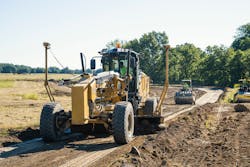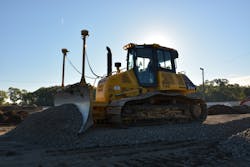Jon Kaye makes no bones about his lack of mechanical experience or expertise. In fact, this member of the Under 40 in Construction Equipment Class of 2023 graduated Embry-Riddle Aeronautical University as a commercial pilot.
His path veered to HERC, where he learned asset management, and then to a series of contractors, where he learned construction. Then, in 2021, Kaye joined Miller Bros. Construction as VP equipment. His arrival at Miller Bros. is indicative of how many of the next generation of equipment managers are bringing a financial focus to equipment management rather than the traditional shop background.
Miller Bros.’ move from operations-driven equipment management to asset management was influenced by Mike Vorster, who sat on the company’s board. When the board decided to make the move, it created the new role of VP and hired Kaye.
Read also: 3 factors that smooth relations between equipment and operations
“Jon understands the business from an overall strategic point of view in addition to the equipment point of view,” Vorster says.
“In the construction world, the company looks at itself as primarily a construction company that happens to own equipment,” says Kaye. “I would argue—and I push our company to understand—that we’re the opposite. We’re an asset-management company that happens to move dirt.”
His experience with HERC’s fleet of construction equipment crystallized Kaye’s approach to asset management. This was 2008, when economic conditions were putting specific pressure on company financials. He learned that fleet performance creates company revenue, and fleet utilization keeps costs low. HERC put Kaye on a team dedicated to process improvement that put him in contact with underperforming branches around the country. Here he learned first-hand how metrics drive revenue.
“We would go in and attack metrics that didn’t meet expectations,” Kaye says. “I got to see a lot of what didn’t work, a lot of when guys had their blinders on. When you manage it, it’s a spotlight.
“I couldn’t replace [that experience] today because I got to see so many different operating environments,” he says.
Process improvement at Miller Bros.
Ernie Stephens, CEM, SVP of equipment at Infrastructure and Energy Alternatives, nominated Kaye for the Under 40 award. Stephens is member of the Class of 2017. In his nomination, he cited Kaye’s “change-management style and process-improvement plans.” Miller Bros.’ board was drawn to both Kaye’s asset-management philosophy and his process-improvement background. The board expected this combination to change the way the contractor not only managed its fleet—with an estimated replacement value of $85 million—but also how it viewed equipment as a corporation.
Read also: Ernie Stephens shows the path to change
“Before my position was [created], the operating groups led the equipment department,” Kaye says. “Maybe not formally, but naturally, because there was a vacuum. The equipment department would respond to requests directly from the operating groups. When you’re in charge of selling work and building work, that’s where 100 percent of your focus is going to be; everything else becomes ancillary.”
The company recognized the need to shift the department’s focus to asset management, using data analysis to manage its capital investment. To illustrate the size of the company’s fleet investment, Kaye compares it to the investment in facilities: “If you graphed it, you wouldn’t even see it.”
Miller Bros. had experienced rapid grown in the years prior to Kaye’s appointment, and equipment operations flourished. “When times are good, revenue covers everything, right? You can run the most inefficient operation and still be an All-Star.” What the company wanted, however, was less luck and more knowledge. With this mandate, Kaye started with his own team, asking for ways they thought the department could become more efficient.
“I remember a specific conversation with my management groups, our equipment manager, our shop managers, our dispatchers. I said, ‘Can we cut $3 million from our budget?’ They all looked at me like I was crazy. They all said, ‘No, there’s no way we have $3 million of inefficiency.’
“‘Fair enough,’ I said. ‘Could we be 10 percent better in everything we do?’ Everyone in the room started [nodding] their head. I said, ‘Great, we had a $30 million budget last year, so if we get better, that’s $3 million.’ You start to connect the dots. We start picking off a couple of little things. We start making quick improvements.”
After two years of process improvement, Kaye turned his attention to staffing. In an industry where career paths almost always run through the shop, changing this would require a new way of evaluating roles and talent.
“We’ve started matching positions to what I think they can excel at,” he says. “We realize that there’s different skill sets for each job. We took one of our shop supervisors who manages our shop mechanics. He was really good [with] mechanical knowledge; he’s not a people manager. We changed his role and gave him a really cool title: equipment excellence manager.”
His focus now is on problem areas, such as machines with multiple failures or categories that struggle financially. “You identify one or two big problems, and you solve them before they become problems,” Kaye says. “And it can be huge.”
Kaye applied his analytical skills to Miller Bros.’ vast array of data, of which the company had not been taking full advantage.
“We have to [be data driven] because the numbers are so big,” Kaye says. “You can’t ignore them. You could have that gut feeling, but the data is telling us what the truth is. There is a balance, it’s just weighing more toward the data.”
Read also: Renew the attack on unscheduled failures
Acknowledging his lack of mechanical skill, Kaye looks to his team for input in those areas. Most times, he says, the mechanical aligns with the analytical. In other cases, a mechanical situation such as an excavator in the shop a lot, for example, forces a look at its machine data. If the data confirms the gut feeling, Kaye acts.
Board role
Kaye also serves on the company’s board of directors, a position that few equipment managers hold—again an indication of how a shift to asset management raises the profile of the equipment department and the person running it. He considers the role as an “extremely important” two-way street, where the holistic view of the company flows into the equipment side and the asset management strategy flows up to the board.
“I can translate that information back to my equipment manager, my maintenance manager, and say, ‘Here’s where we’re heading.’ I’m not hearing it third person; I’m part of that conversation,” Kaye says. “If you talk to a lot of equipment managers, there are a lot of fire drills. Why? Because we would find out a week before [that] we’re going to start this new venture, or we won this new project. I can get that information much sooner and provide feedback, and then also push back on it.
Pushing back is not a negative part of the conversation, according to Kaye. With the heads of not only the operating teams in the room, but also accounting and human resources, the board hears the equipment implications on decisions.
Read also: Mesh long- and short-term views for excellence in equipment management
“My role is to say, ‘Hey, guys, we can do whatever you want, but here’s what it’s going to cost in both capital dollars and manpower. You show how the margins are going to flow through, but in Year 1, I’m going to buy a lot of equipment.’
“They need someone to show them what’s on the dark side of the moon that they’re not seeing,” he says. “I can look straight at my CFO and say, ‘Based on what we talked about, I’m going need a little bit more in the piggybank.’ We are all here at the same time in the same place.”
Kaye says he considers his role on the board to maximize return. Revenue comes into the company via the equipment that does the contracted work, so managing those assets well means winning more work.
“That's what facilitates us to win more work,” Kaye says. “I have to be a little bit better than my competitor in how I manage my fleet.
With or without the “executive” title, Kaye says an asset manager with data can bring a level of financial acumen to corporate or management discussions.
“It’s important to not think that the title matters,” he says. “If you have the data to support what you’re saying, be that guy that’s willing to raise your hand. You should be pushing up and saying, ‘Here are the metrics I’m managing.’ That message will spread, and the company will say, ‘We need more of this.’”
When the leaders at Miller Bros. came to this realization, Kaye says, that brought about the transition to making financial asset management of the fleet a full-time job.
About the Author
Rod Sutton
Sutton has served as the editorial lead of Construction Equipment magazine and ConstructionEquipment.com since 2001.
Our mission is to help managers of heavy equipment and trucks to improve their performance in acquiring and managing their fleets. One way we do that is with our Executive Institute, where experts share information and ideas that will enable equipment managers to accurately manage equipment costs so that they can deliver the optimum financial benefits to their organizations.
We also have a laser focus on product development, performance, and technology; as well as equipment acquisition, disposal, and maintenance. Our exclusive Field Tests take earthmoving equipment and truck into the field for professional evaluations.
Check out our free newsletters to see the latest content.
You can find Sutton on LinkedIn.



